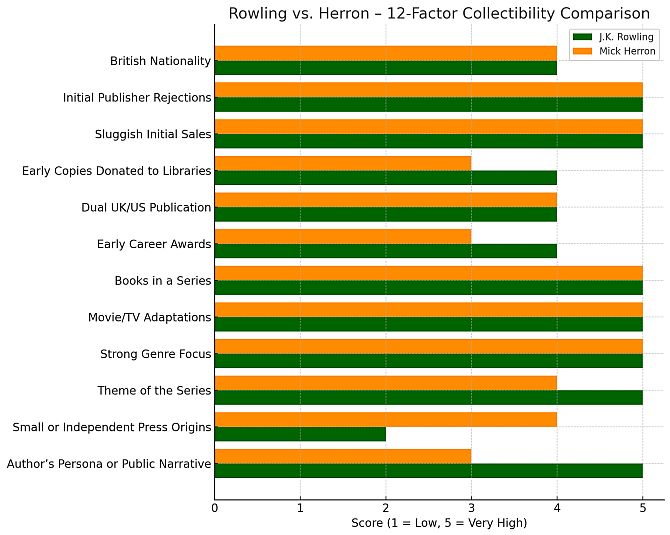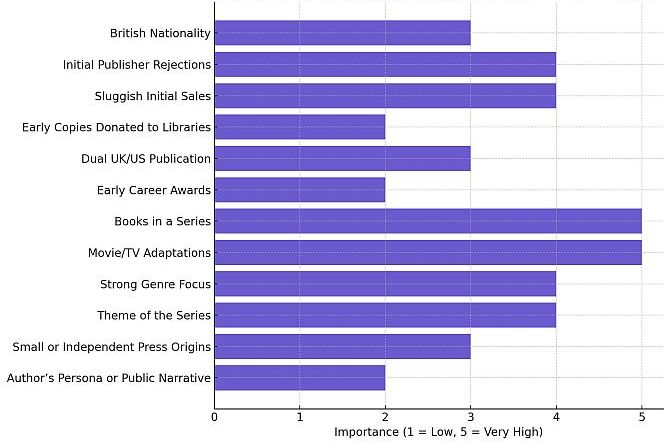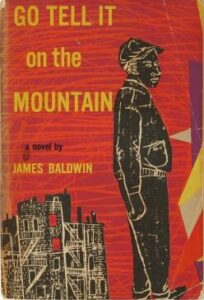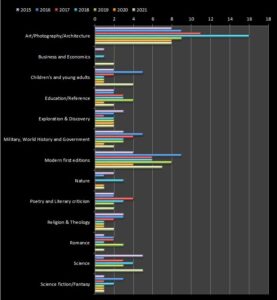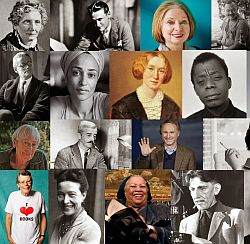 In our previous post, The Factors Fueling a Collectible Author, we attempted to identify the most salient factors behind J.K. Rowling’s impressive collectible trajectory. In collaboration with affiliates at Rarebooks.AI, we used the 12 factors identified to build a predictive analytical model. It is designed to identify authors who have the potential to become collectible within a relatively short period of time. The authors evaluated align with some of the early-stage characteristics that contributed to Rowling’s boost in scarcity and demand. The model’s training process was supervised and, for this particular exercise, limited to British authors only.
In our previous post, The Factors Fueling a Collectible Author, we attempted to identify the most salient factors behind J.K. Rowling’s impressive collectible trajectory. In collaboration with affiliates at Rarebooks.AI, we used the 12 factors identified to build a predictive analytical model. It is designed to identify authors who have the potential to become collectible within a relatively short period of time. The authors evaluated align with some of the early-stage characteristics that contributed to Rowling’s boost in scarcity and demand. The model’s training process was supervised and, for this particular exercise, limited to British authors only.
British nationality is one of the contributing factors identified, with a 3 out of 5 ranking, in our Collectible Author Framework. According to PublishersWeekly.com, “the UK is the world’s largest exporter of books, with 60% of its publishing revenue—amounting to £4.1 billion—coming from international markets. The United States stands as the UK’s largest export market for both print and digital books, with sales increasing from £193 million in 2018 to £260 million in 2023.” Setting British nationality as a real-valued visible variable strengthened the rest of the predictive model’s factor analysis correlations.
More UK authors are also opting for hybrid models, with dual UK/US publications, in order to gain traction in the US market. Being highly influential in both the UK and US literary scenes is often a well-positioned approach to global reach.
While a number of the authors considered have a proven collectability track record, the duration it took them to reach such a level is relatively long, sometimes a lifelong. The model has a second real-valued constraint set: “time interval to become highly collectible must be less than two decades.”
A third and final real-valued parameter was set to include only “authors who are still alive,” still being published, and actively evolving.
Armed with the 12 factors and 3 real-valued constraints, AI’s pick for a Rowling-adjacent success story in the making was clear: Mick Herron, the Oxford-based author — a late-blooming collectible powerhouse — who gained wider attention with the success of the Slough House series and its Apple TV+ adaptation (Slow Horses).
The book series debuted with Slow Horses, which came out in 2010. Herron writes in the classic British spy thriller tradition, but with a unique satirical twist. Career recognition came in 2013 when he won the CWA Gold Dagger award. He draws comparisons to John le Carré, Ian Fleming, and Len Deighton.
Herron’s early works struggled to find a market. He debuted in the early 2000s with his first novel, Down Cemetery Road (2003), published by the small indie press Constable & Robinson. Many of those early copies went to libraries. The third book in the Oxford series, Why We Die (2006), had a US publisher added: Avalon-owned Carroll & Graf. Carroll & Graf Publishers shut down the following year.
The next book in the Oxford series, Smoke and Whispers, as well as the first book in the Slough House series, Slow Horses, were published by Soho Constable — a co-publishing venture of UK publisher Constable & Robinson and US publisher Soho Press. With his series about second-rate spies, Herron felt like he finally had momentum — but his publisher disagreed. It decided to stop publishing him. Nobody wanted to publish Dead Lions, the sequel to a book that nobody was buying.
At that point, Soho Press, the independent publishing house in New York with a crime imprint, ended its Soho Constable co-publishing venture and began publishing Herron directly.
Mick Herron’s first series, first book, Down Cemetery Road, is now being adapted into a series by Apple TV+. The series stars Emma Thompson and Ruth Wilson, and it is the second adaptation of Herron’s works by Apple TV+, following the popular Slow Horses, which has been renewed for fifth and sixth series based on the novels London Rules, Joe Country, and Slough House.
Both genres — Fantasy (Rowling) and Spy Fiction (Herron) — are valuable. But fantasy is the rocket, and spy fiction is the stock that matures quietly — then explodes. Rowling delivers faster, broader, and more dramatic collectability in a crowded field. Herron offers slower-burning, niche-driven rarity — ideal for strategic collectors looking for value before a pop culture boom (like an expanded Slow Horses universe).
Both authors’ books have strong, resonant themes which tend to stay relevant longer and encourage long-term collecting. They are more likely to be taught, discussed, adapted, and reprinted — all of which fuel collector demand for first editions.
Slow Horses (2007, Constable): Initially obscure; first editions now exceed $3,000 in fine condition — and rising fast.
{ 0 comments }
